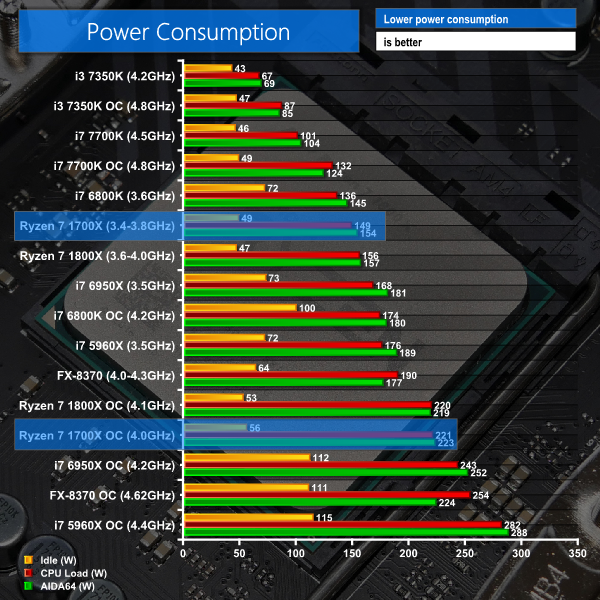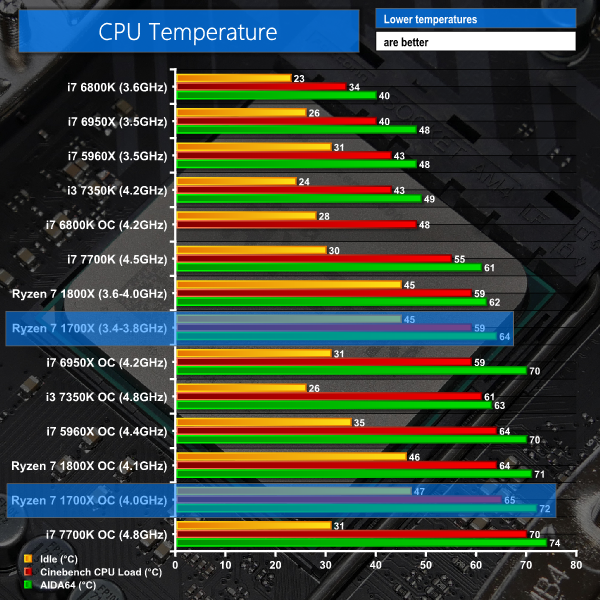We leave the system to idle on the Windows 10 desktop for 5 minutes before taking a power draw reading. For CPU load results we read the power draw while running the Cinebench multi-threaded test as we have found it to push power draw and temperature levels beyond those of AIDA 64 and close to Prime 95 levels. Cinebench has a short run time on high-performance CPUs which influences the validity of the temperature reading, so we run AIDA64 stress test to validate data.
The power consumption of our entire test system (at the wall) is shown in the chart.
The same test parameters were used for temperature readings.
Power Consumption
Power draw readings are accurate to around +/- 5W due to fluctuations in the value even at sustained load. We use a Platinum-rated Seasonic 760W PSU and install a GTX 1070 video card that uses very little power.
Power consumption for the Ryzen 7 1700X is slightly lower than that of the 1800X at stock clocks. This is due to its 200MHz lower operating frequency.
The picture changes when overclocked, though. While the difference in power draw between the 1700X and 1800X is too small to declare an outright victor, the latter is operating at a greater VCore for its higher clock speed but still manages to draw practically the same power. This gives an indication of the higher quality silicon used for the 1800X that is able to more efficiently transfer electrical power in useful work.
The 1700X draws a little more power than an i7-6800K at stock frequencies but it also offers greater computational performance. When both CPUs are overclocked, the 1700X demands noticeably more power in Cinebench than the 6800K but for that additional electricity usage it returns a 35% higher score.
Temperatures
Temperature recordings were taken using the Noctua NH-D14 for the LGA 1151 test system, Cryorig R1 Ultimate for the LGA 2011-3 system, and Noctua NH-D15 for the AM4 system. We use different coolers for speed purposes. Each CPU cooler's fans were running at full speed. Ambient temperature was maintained at around 20°C.
Due to the use of slightly different CPU coolers, our temperature measurements should only be used as a guideline. Performance differences below around 3°C are small enough to say that cooling results were similar.
Update 17/03/2017: AMD has announced that Ryzen 7 1800X and 1700X have a +20°C temperature offset on the reading currently displayed by software, over the actual junction temperature. AMD is advising that 20°C can be subtracted from the reported Ryzen 7 1800X and 1700X temperature values to understand the actual junction temperature.
Temperature levels for both Ryzen 7 CPUs are similar. The 1700X tends to be a little hotter using our overclocked settings, despite the 1800X operating at a higher voltage level. This, again, points towards higher quality silicon for the 1800X, though that's to be expected from the more expensive part.
AMD's soldered heatspreader design with liquid-metal TIM does a good job at keeping the CPU well-cooled under load.
Be sure to check out our sponsors store EKWB here
 KitGuru KitGuru.net – Tech News | Hardware News | Hardware Reviews | IOS | Mobile | Gaming | Graphics Cards
KitGuru KitGuru.net – Tech News | Hardware News | Hardware Reviews | IOS | Mobile | Gaming | Graphics Cards




